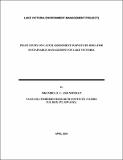| dc.description.abstract | The need to have a functional CAS system for Lake Victoria fisheries, to monitor changes
and have reliable indices of relative abundance for the management of fisheries resources has
been realised by all stakeholders interested in the sustainability of the fishery resources. The
necessity to restore and strengthen the CAS system was equally expressed and recognised
under the LVEMP by World Bank ‘Aide Memoir’ (AIDE MEMOIR
RECOMMENDATIONS SECTION 44).
Following these concerns, this study with an objective to evaluate the performance, the extent
of training needed and the mechanisms to ensure reliable catch statistics are collected by the
BMUs was conducted by TAFIRI in collaboration with District Fisheries Officers in three
selected beaches in Mwanza Region. This pilot study was conducted for 18 days, six days in
each of the beaches (Chole in Misungwi, Ihale in Magu and Kijiweni in Sengerema Districts
respectively. Interviews, training and experimental data collection were conducted for two
days each in the respective landing sites The interviews gathered information from 90 respondents of age group between 18 to 80 yrs.
Their level of education mainly was Primary School Certificate (67%), 23% were Secondary
School leavers while 7% were below standard VII and 3% illiterate. About 70% of all the
respondents were willing to collect fisheries data on payment of TZS 1000/= to 3000/=.
Among the 70 respondents, 26 (35%) were BMU members and 44 (65%) were non-members
to BMUs. Training was in two sessions, first session was on ‘the importances of catch
statistics and the trends in catch and effort: management perspective and policy and planning
for sustainable fisheries. Decline in CPUE as an indicator of overexploitation was
emphasized. The effect of uncontrolled effort and impact of illegal gears and practises were
detailed covered’. This session created awareness to all age groups of different education
levels. The second session was on the data forms to be used. The terms used had to be
elaborated and how to record and measure for the different parameters. This appeared to be
technical due to the language used in the forms (English). All the trainees in the respective landing sites attended the experimental data collection
exercise. Their performance was judged during recording and measuring of fish, their
promptness to follow a landing boat and keenness in the whole exercise. BMU membership and being a residence were added qualities. Of the twelve members selected (4 in each of the
three landing sites), 5 were BMU members and 7 non-members. Leaders of BMUs and of the
village Councils were encouraged to oversee the operations and not to participate in the data
collection directly. The non-members to BMU proved to be competent than some of the
BMU members.
To overcome the main obstacle of limited and unqualified manpower after retrenchment,
engaging the landing site communities, in particularly the BMUs, will ensure sustainability in
data collection. However, training to create awareness and commitment, has to be conducted A protocol to involve BMUs in CAS is detailed discussed but training before they are
assigned any responsibility is crucial. Likewise, it is impossible to expect to get any valuable
fisheries data without any investment. The payment of 2000/= or 3000/= Tanzanian Shillings
per day has to be considered. More commitment is needed from the sector planners and
managers to direct resources to monitoring of the fishery. The Fishery Department have to
include CAS budget in her annual budgets to be approved and allocated as a budget line
under government funds. However, the currently existing projects as LVEMP, SIDA and
IFMP could be consulted to fund the reviving and establishment of a functional CAS system Caution is needed as BMUs may not be willing to portray their beaches to be non-compliant
to management regulations and thus illegal gears may not be recorded. Occasional checks by
fishery officers are very important. There is also a need for the research institution to conduct
independent quarterly surveys to give an independent estimate of the stocks and monitor
changes in CPUE and the fishing practises while collecting biological information, which
may not be collected by the BMUs. | en_US |

